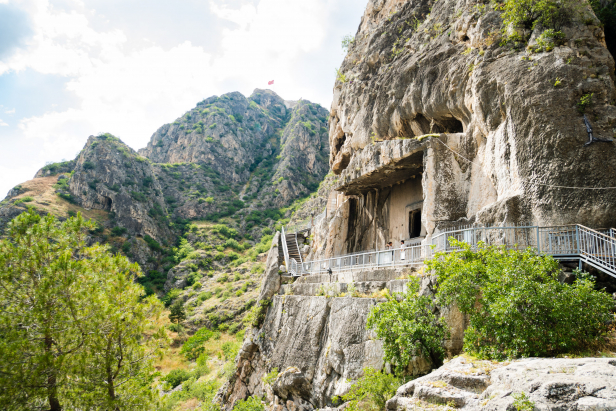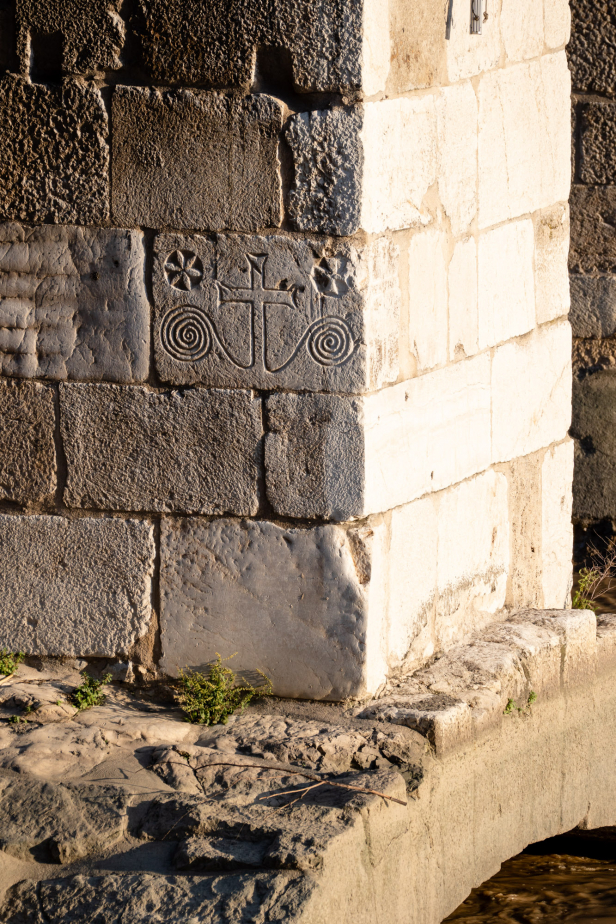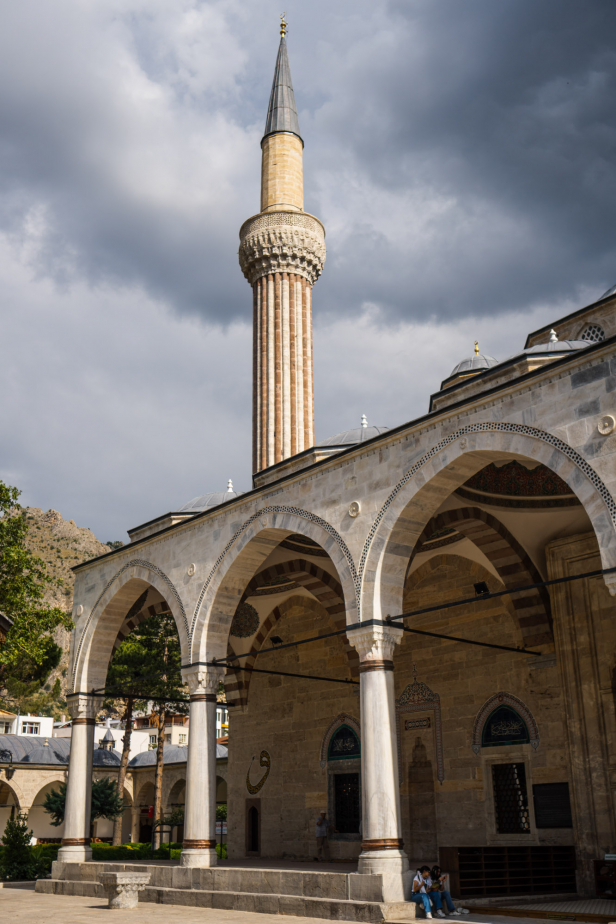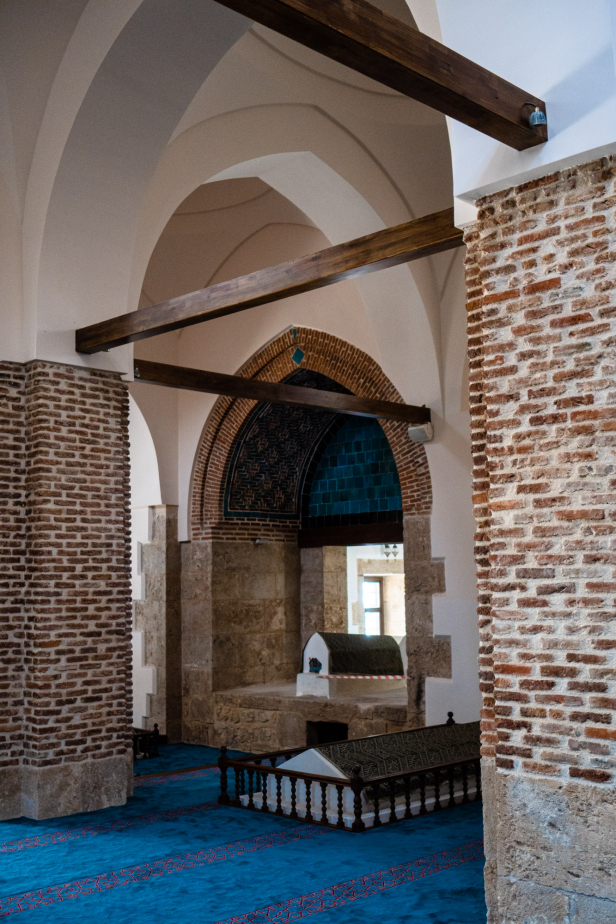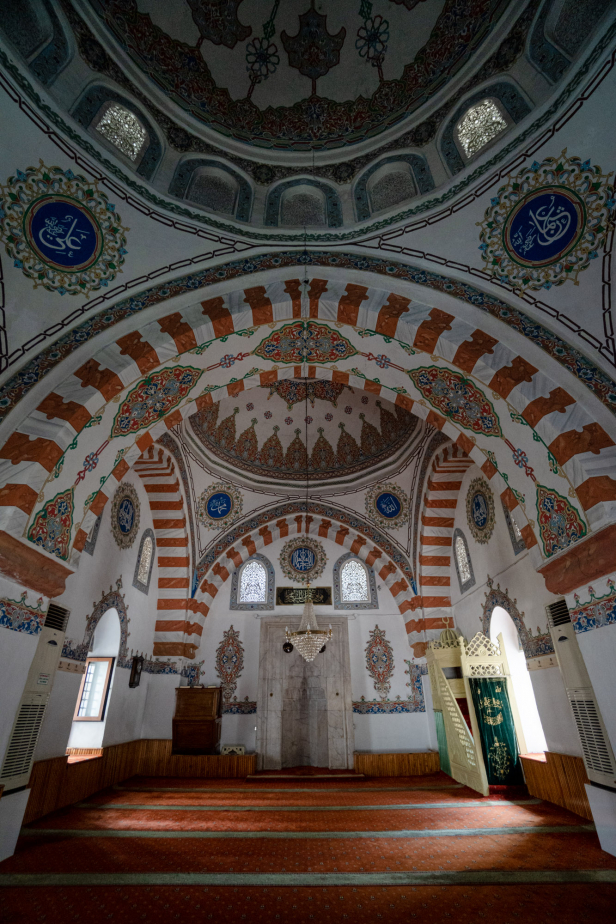The City of Amasya
/ By Josh
While there are many places in Turkey with rich history or a beautiful setting, there are few like Amasya. In Amasya over 3,000 years of history sits blended together, visible from all over the city, this combined with its stunning setting in the midst of a deep canyon with a river running through its heart makes Amasya truly spectacular. The monuments of the Ottomans and Seljuks rise above and peer between the modern buildings of Amasya, Ottoman houses of wood and cream-coloured plaster loom out over the brown waters of the Yeşilırmak River and, backdropping it all, is a great cliff with the tombs of ancient Pontic kings carved into its face and topped by a castle founded by the Hittites.
History
During the Bronze Age the Hittites established the castle of Harshema on the high mountaintop above the bend of the Yeşilırmak (Green River). The site was so strategic that it would go on to be used for thousands of years by numerous cultures and civilizations.
Following the collapse of the Hittite Empire the city lay quiet under the Phrygians until the Persians arrived, conquering vast swaths of what is now Turkey in the 6th century BC. In the 4th century the arrival of Alexander the great ended Persian control of the region, though Alexander’s short lived empire fractured with his death. In the aftermath of warring factions, the independant kingdom of Pontus was formed by Persian Satraps (governors) who made Amasya their capital.
Subscribe to The Art of Wayfaring
The Kingdom of Pontus flourished as a Helenistic kingdom and the kings built great monumental tombs for themselves in the cliffs below the castle. Shortly before the end of the Kingdom of Pontus, Amasya’s most famous resident was born. Strabo (Strabon), known as “the Father of Geography” was born in Amasya around 64 BC. He wrote books describing the lands of the ancient Mediterranean, making detailed descriptions of landscapes, climates, peoples, and customs for the benefit of statesmen and rulers.
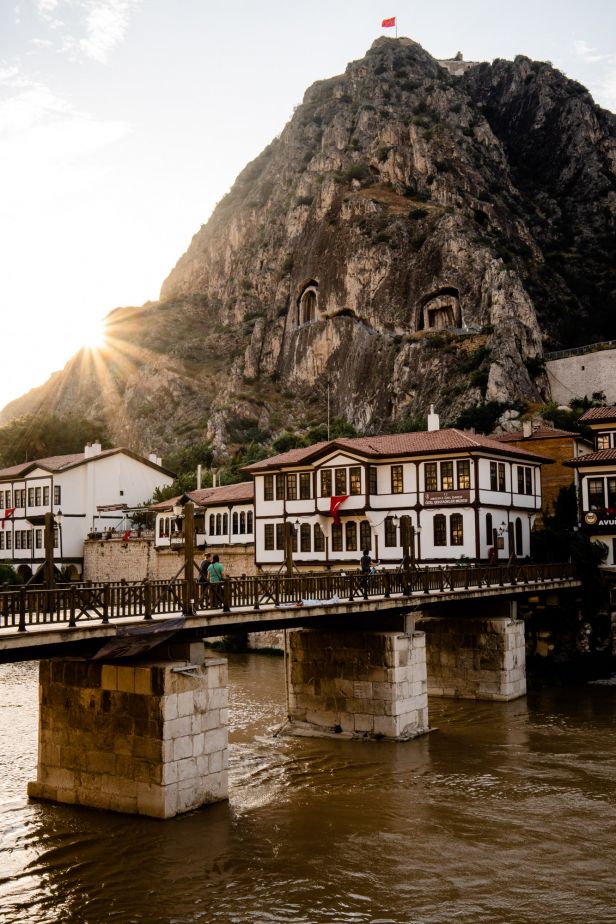
During the life of Strabo The Kingdom of Pontus fell to the Romans, the Pontic army being defeated by Julius Ceasar at the Batte of Zela (now the nearby castle town of Zile). The campaign against the Kingdom of Pontus was so short that Ceasar uttered his famous Vini, Vidi, Vici, “I came, I saw, I conquered” in reference to how quick it was. While the city of Amasya (Amasea) found itself under new rulers, it continued to prosper throught the period of Roman rule.
Roman gave way to Byzantine rule and with it the wealth and peace of the Roman period gave way to instability and unrest. In 1071 the Seljuks defeated the Byzantines at the Battle of Manzikert (Malazgirt), opening Anatolia to the various Turkic tribal groups of central asia and the caucasus. Four short years later Amasya fell to the Danishmendids, ending 700 years of Byzantine rule.
Danishmendid rule was short lived and was replaced by Seljuk rule as the Turkic peoples of the region were gathered into a more unified political entity. After the Battle of Köse Dağı, the Seljuks became vassals of the Mongol Ilkhanate. These different cultures added to the legacy of art and architecture of Amasya with fine tombs and mosques.
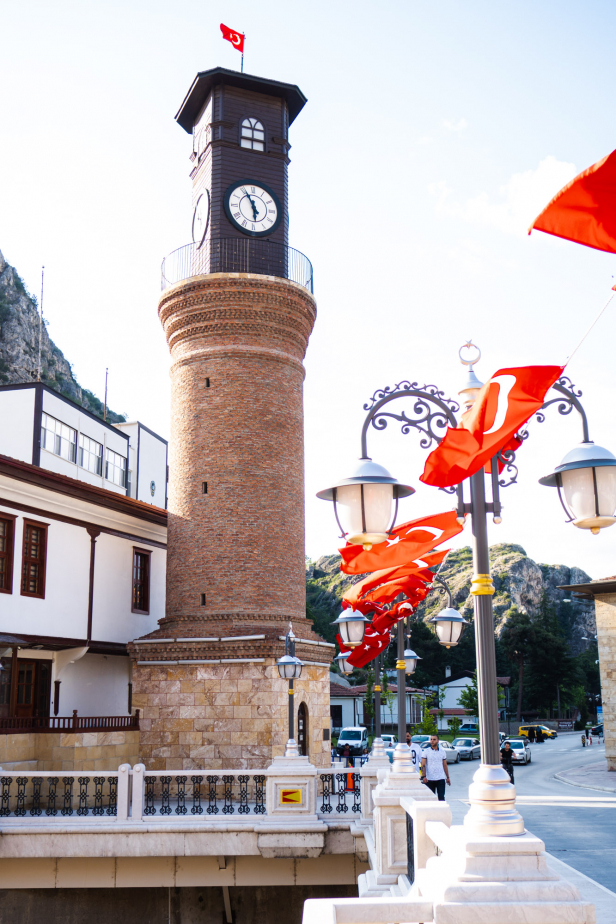
The Ottomans, who had gained indirect control of the city gained absolute control over Amasya by the mid 15th century. Under the Ottomans this small provincial city was to gain special importance. In 1402 the Ottoman Sultan Beyazid I was defeated and captured by Tamerlane (Timur) at the Battle of Ankara. In the power vacuum the princes led the country into a civil war. Prince (Şehzade) Mehmet took shelter in Amasya and, after gaining the throne began a tradition where Ottoman sultans would send prominent sons to Amasya to serve as governors, gaining experience before potentially taking the reigns of the empire. As the home to generations of Sultans-to-be, Amasya was endowed with grand building projects, wealth, and prestige. This practice continued up to the 17th century.
Why Visit?
The Tombs of the Kings of Pontus
(Pontus Kralları Mezarlari)
Cost: 10TL
One of the most striking sights of Amasya are the carved tombs of the Pontic Kings, set high in the rock above the bustling city. While there are others in the area, the five that are carved dramatically above the city itself are the most impressive and best known. The tombs, which date back to the 3rd century BC, are all built to a vaguely similar plan. The fronts are carved like a flat wall under an eave, either arched or pointed like a pediment. A small door in the front façade opens into the grave chamber. These tombs are not simple façade as they appear at a distance. They are almost completely separate from the natural cliff with a space running behind and over the tomb.

The Kings of Pontus were a dynasty of ex-Persian satraps, or governors, and so all bear Persian names such as Pharnakes and Mithridates.
Walkways and tunnels carved into the cliffs make the tombs easy to access suggesting that these tombs were meant to be visited by large groups as a part of the practice of venerating the dead.
Below the Tombs of the Kings of Pontus are the remains of a palace complex called the Maidens Palace (Kız Saray). While there is little left to see here it was in use even in the Ottoman period and consisted of a residence, baths, and kitchens.
Subscribe to The Art of Wayfaring
Skip to the bottom of this page to read about the Aynalı or “Mirror Tomb”, a tomb similar to the Tombs of the Pontic Kings on the outskirts of Amasya, or read our guide to the Kapılıkaya Tomb, another mysterious rock-cut tomb in nearby Çorum Province.
Yalıboyu Historic Ottoman Houses
(Yalıboyu Osmanlı Evler)
Cost: Free
With the Tombs of the Kings of Pontus above and the flowing water of the Yeşilırmak River below, the traditional wood-and-plaster houses of Amasya are a part of the city’s beauty and charm. While relatively humble compared to the Seljuk Madrasahs or the soaring Ottoman domes, the Yalıboyu houses are a central part to the charm and character of Amasya. They sit tightly packed together, lining the west bank of the river, defying gravity on cantilevers and jutting out above the river itself.
The western side of the city is a narrow space, stuck between high cliffs and the riverbank. Many of the houses here are still old Ottoman houses, and even many of the new construction is being built to traditional designs making this one of the most beautiful neighbourhoods in Amasya. Many of old houses have been converted into boutique hotels, cafes, bars, and restaurants with seating inside or in garden-like courtyards where you can enjoy Amasya’s mild summer nights. Full of nightlife and lights this area is especially beautiful to walk at night.
Roman “Low” Bridge
(Alçak Köprüsü)
Cost: Free
Built by the Romans, this bridge has connected the east and west banks of the Yeşilırmak river for 2,000 years. Today the old Roman bridge is barely visible and the silt brough down from far away mountains has filled the river bed and raised the water level. If you go in the morning you can see the tops of the old Roman arches. By evening the water level is raised by a set of dams to allow tour boats to pass over the arches safely. The name “Alçak” or “Low” comes from the fact that much of the bridge is now below the water’s surface.
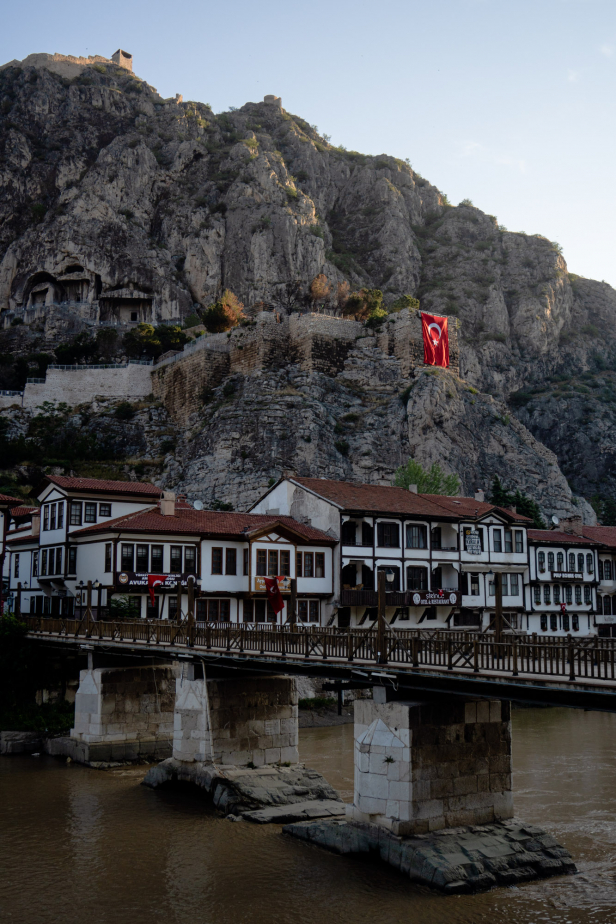
With the bridge so low in the water a new bridge deck had to be constructed. Earlier attempts at raising the bridge were washed away during storms and the stone piers you see today, set on top of the Roman arches, date back from 1865. The piers were made using spoila from other buildings and you can see inscriptions and a stylized cross just above the water.
The Beyazid II Complex
(II. Beyazid Külliyesi)
Cost: Free
Built in 1486 by Sultan Beyazid II, this mosque and its complex is the largest and grandest in the city. Before taking the throne, Beyazid II spent considerable time in Amasya, initially for his education then as a governor. In addition to this complex in Amasya, the 250-meter-long Koyun Baba bridge in the Town of Osmancık was included in the same project.
The design of the mosque is an inverted “T”, made up of a pair of large domes forming the long axis of the space for prayers, with a pair of wings formed by lesser domes, fronted by a wide portico. This style was popular in the early Ottoman empire (see the mosques of Bursa for other examples), but would give way to the centralized style favoured by the Ottomans in the 16th century onward (See Süleymaniye and Selimiye for the highpoint of this style).
The mosque interior is dominated by walls of cool marble and a plastered ceiling painted with colourful motifs. The cool tones and the large windows make the space light and airy compared to many mosques built in this style.
Outside, directly across from the mosque entrance is a large shadirvan, a fountain used for ritual washing before prayers. The fountain is covered by a large conical roof, with a small dome underneath bearing frescoes similar to the city scenes of Merzifone’s Karamustafa Paşa Mosque.
To the east of the mosque is an imaret, or soup kitchen, built in the shape of an “L”. Today the imaret building hosts the Amasya Miniature museum where you can see a scale model of Amasya with its castle, river, and various sights in miniature.
To the west of the mosque is a “U” shaped madrasah with a garden-like courtyard surrounded by a portico and various rooms that served as classrooms. In the center of the south wall is a larger room under a fine dome that would have served as a room for prayers as well as a larger classroom. Today the madrasah is used as government office space.
Amasya Castle / Harshena Castle
(Harşena Kalesi)
Cost: 10TL
Approximately 4,000 years old, Harshena Castle dates back to the Hattian culture, the predecessors of the Hittites. The name Harshena comes from Harshuwana, meaning “Beautiful River Town”, a name the castle has retained for its entire history. The castle with its hard-to-reach position and commanding view of the river valley has been in use for millennia by Hattian, Hittites, Phrygians, Persians, Kingdom of Pontus, Romans, Byzantines, Danishmendids, Seljuks, Mongols, and finally the Ottomans. While the castle is a work of thousands of years, successive builders tended to remove the work of previous inhabitants and built new stronger walls, so much of what there is to see now dates back only as far as the Hellenistic period (2,300 years ago)
Set 280 meters above the city itself, the castle was connected to the valley via a massive tunnel, known as the Cilaboyu Tunnel, which is believed to be 2,300 years old. The naturally fortified position was added to with sets of inner and outer walls and a settlement inside, complete with mosque, alms houses, baths, and residence.
Birmahane / Seljuk Hospital
(Amasya Darüşşifa/Sabuncuoğlu Tıp Müzesi)
Cost: 10TL
Built in the ornate style of the Seljuks, the birmahane or Darüşşifa was founded as a hospital. The building, constructed in 1308, is designed around a long central courtyard with a large open iwan at the eastern end. The courtyard is narrow, lined with pillars and various rooms that served as rooms for treatment. In typical Seljuk style, the front façade is incredibly grand and ornate, consisting of a detailed muqarnas vault, niches, and numerous patterns both sharp and geometric as well as curving and floral. The facade of the Amasya Birmahane displays the finest masonry in Amasya.
As treatment of the sick was traditionally carried out at home, this hospital would have served travellers as well as special cases. For a period the hospital specialized in the treatment of the mentally ill, and put great emphasis on the uses of music and peaceful atmosphere to calm patients.
Today, the ancient hospital is a museum, displaying historical medical books, surgical tools, as well as historic medical practices.
There appears to be some debate regarding the origin of the hospital, whether it was built by the Seljuks, or by the Mongol Ilkhanids. According to the epigraph stone the hospital was built in 1308 by Ilkhanid Sultan Olcaytu Muhammed for his wife, Uduz Hatun. Some experts argue however that the building must have been built by the Seljuk Sultan Keykubad I, then recommissioned by the Ilkhanids who also replaced the epigraphical stone. They also point to the fact that these hospitals took four years to build on average, and the Ilkhanids only took control of the city in 1308, the same year the hospital was completed. One issue with this view is that the Ilkhanids already had indirect control of the region as of 1243 after the Ilkhanids defeated the Seljuks of Rum in the Battle of Köse Dağ, after which the Seljuks were vassals of the Ilkhanids.
Whatever the exact origin of the Birmahane, it is a beautiful historic structure that displays the history of medical knowledge and practice in the region.
Gök Madrasah, Mosque, and Tomb Complex
(Gökmedrese)
Cost: Free
Built in the mid 13th century by Seyfeddin Torumtay, governor of Amasya, this complex consists of a set of two mausoleums, a mosque, and a madrasah. The name “Gök” meaning sky, is said to come from the sky-blue tiles on the brick cupola built next to the mosque. The most striking part of the complex, the cupola is a Kümbet, or tomb with a unique pleated pyramidal roof set on an octagonal drum.

The mosque interior has been recently restored and the ceilings are of unadorned white plaster. Whether or not this is the original style is unclear.
The tomb of Seyfeddin Torumtay himself is actually the large rectangular structure built across from the entrance to the mosque itself. This was added about a decade after the building of the mosque itself.
Yorgüç Mosque
(Yörgüç Camii)
Cost: Free
Built only a short distance above the river in the west of the city, Yorgüç Mosque was built by Yorgüç Paşa in 1431 during the reign of Sultan Murad. The mosque is built in an inverted “T” style, similar to the above mentioned II. Beyazid Mosque as well as Bursa’s Muradiye mosque which was built by Yorgüç Paşa’s master, Sultan Murad. Yorgüç Mosque is somewhat small and the interior is dark, though the ceilings are filled with colourful curving patterns of the Ottoman style. Rather unusual for an Ottoman mosque is the heavy use of spoila (re-used stones with inscriptions or reliefs) in the walls.
Halifet Gazi Tomb and the Tombs of the Qadis
(Halifet Gazi Türbesi ve Kadilerin Mezarları)
Cost: Free
Built for the Danishmendid governor of Amasya, this tomb follows the classic Seljuk pattern for monumental tombs with a high octagonal drum capped with an octagonal pyramid. The octagonal shape is made irregular by widening the front façade and shrinking the sides so as to allow a larger space for the fine stone patterns and motifs that adorn the front. The fact that the tomb was part of a now demolished wall further muddles the shape of the original building.

Across from the Kümbet Tomb of Halifet Gazi are a number of tombs under a pair of large iwan vaults. The tombs belong to the Qadis of Amasya, religious experts who often served as judges. The date of construction for the iwans is unknown but there is a great amount of Greek/Byzantine spoila in the area and the site must have been home to other important buildings in the past.
Beyazid Paşa Mosque
(Beyazid Paşa Camii)
Cost: Free
Built near the river in the east of the city, Beyazid Paşa mosque was built in 1414 by Beyazid Paşa, who served as grand vizier in the Ottoman Empire (not to be confused with Sultan Beyazid). The mosque is similar to the other abovementioned mosques in that it too is built in the inverted “T” style of the early Ottoman Empire. The front portico of Beyazid Paşa Mosque is rather different than the others, with heavy square piers supporting the domes above, The wide surface of the piers connect with a flat face above to form more of a facade than an open portico as with the pillard portico of II. Beyazid Mosque.
Büyük Ağa / Kapı Ağa Madrasah
(Büyük Ağa / Kapı Ağa Medresesi)
Cost: Free
Built in the eastern part of the city, north of the river, is a particularly beautiful madrasah, named for its founder Hüseyin Bin Abdülmuin, known by his title of Kapı Ağa or Büyük Ağa. Hüseyin Bin Abdülmuin served as chief Eunich under Sultan Beyazid II, and commissioned the madrasah which was built in 1488.

The madrasah is unique for its time, built as a generous portico centered on an octagonal courtyard. Opening into the courtyard are a number of classrooms as well as one larger domed room on the south side serving as a space for prayers.
After an earthquake in 1939, the madrasah was in a state of near-complete ruin. In 1980 it was restored and today it is again used as originally intended and religious lessons are given in the historic building.
Turkish Baths
(Hamamlar)
Cost: Varies
A historic city, rich in Ottoman endowments will always be home to a Turkish Bath or two and Amasya is no exception. The Hamams of Amasya are high quality, though some were closed for renovation when we visited.
Kumacık Hamamı – a large 15th century bath house on the eastern end of the city.
Yıldız Hamamı – Somewhat smaller, this early 16th century bath was built just above the river on the north bank amongst the Yalıboyu Ottoman Houses.
Mustafa Bey Hamamı – Built by Mustafa Bey, son of Yorgüç Bey (builder of the abovementioned mosque), in the mid 15th century. While plain looking from the outside the interior is beautiful and authentic.
The Amasya Taşhan
(Amasya Taşhan)
Cost: Closed
The Amasya Taşhan was built in 1699 to serve travellers and caravans. It served their needs as a hotel but also contained shops that opened on the exterior where caravans could buy goods or get repairs on their gear. As with other han or countryside caravanserai the Amasya Taşhan was built like a small fortress with high, heavy walls and one main entrance set in a tower-like gatehouse.
Until recently the han was used as a hotel, though as of 2022 it was closed. Whether or not there are plans to reopen the han as a hotel or something else is unclear at the moment.
The Amasya Bedisten
(Amasya Bedistanı)
Cost: Free
Today only a portion of the original bedestan, or covered marked, has survived. On the lower side of the building you can still see where the heavy stone walls continued down the hill. The portion that remains now is still large, about the same size as many other bedestan found in smaller cities. The building consists of a single large room topped with a set of four domes and was built in in 1483.
Archaeology Museum
Arkeoloji Müzesi
Cost: 15TL
Museum Card Accepted
Though not large, the Amasya Archaeology Museum is packed with fascinating items ranging from fossils to historic finds from the long history of the city and region in general. Alongside the ancient Hittite and Roman items are items from more recent history, depicting the traditional culture of Ottoman Amasya. Particularly interesting (though somewhat gruesome) are the mummified remains of the Ilkhanid Mongol nobles, with the remains of men, women, and children on display.
Outside there is a large collection of stonework, mostly tombstones, from the Islamic and Christian periods. Also in the garden is the Sultan Mesüt Tomb where the mummified remains had previously been displayed.
(Aynalı Mağara)
(Aynalı Mağara)
Cost: Free
A short distance downstream from the city of Amasya, the Mirror “Cave” is actually a royal tomb of the Kings of Pontus. This tomb is dated to the 2nd century BC, and is somewhat taller than those built above Amasya, and similar in appearance to the Kapılıkaya Tomb in nearby Çorum Province. While similar to the other Pontic tombs this one is particularly interesting for the massive inscription on its face reading “High Priest Tes” in Greek characters while another inscription has been removed from the façade at some point in history. The tomb was reused during the Byzantine period and a fresco depicting the 12 disciples of Christ was added to the vault of the inner tomb. The name “Aynalı” or “Mirror” is believed to come from the way the smooth face of the tomb shines in the light like a mirror.
How To Get There
General
Amasya is a mid sized city and well connected to everywhere by a set of good highways and inter city bus service. The nearest airport is in the Town of Merzifon, though flights are rare and the only airline with flights to Merzifon is Turkish Airlines and its subsidiaries. If the flights to Merzifon don’t work for you your next best option may be Samsun airport, about 150 kms away.
For more about car rental and driving in Turkey make sure to read our full drivers guide.
Where To Stay
If you’re looking for a unique experience, the Yalıboyu Ottoman houses on the north side of the river offer the chance to stay in a historical Ottoman mansion, often with views of the river or cliffs above. For something a little more modern there are plenty of hotels to choose from and the market is growing as Amasya’s popularity with tourists grows.
Other Tips
Planning on visiting Amasya? Make sure to check out what sights are in Amasya Province and nearby Çorum Province.
Subscribe to The Art of Wayfaring
Have any tips or info to add? Spot any mistakes? We’d love to hear about it.
